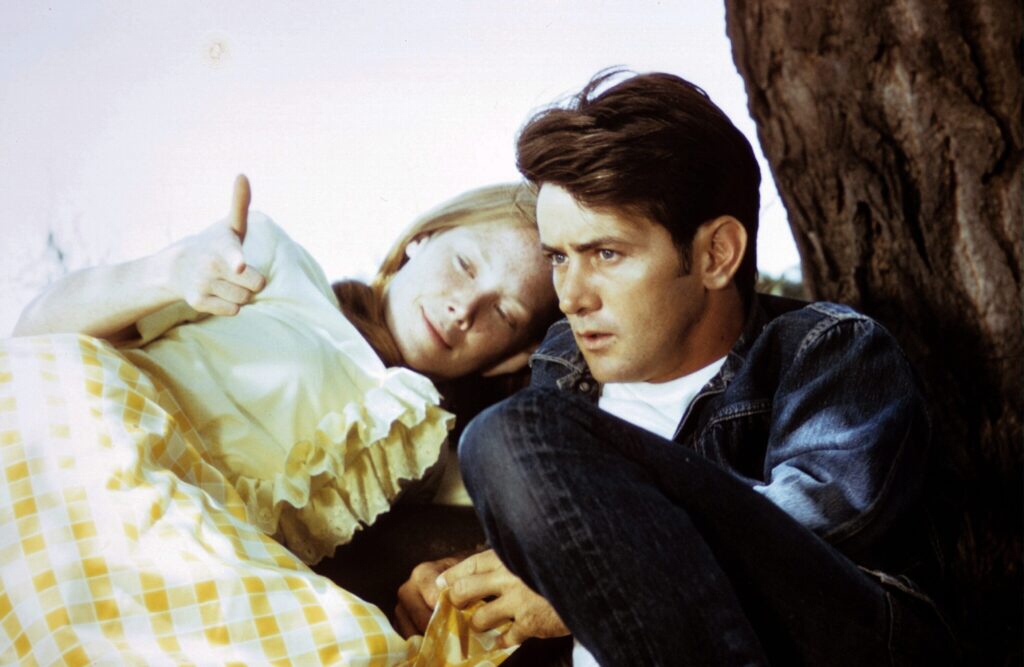Holly is a 15-year-old girl living in a South Dakota town with her father. “Little did I realise,” she narrates in voice-over, twirling her baton on the street, “that what began in the alleys and back ways of this quiet town would end in the badlands of Montana.” What begins in the alleys and back ways of her quiet little Texas town is a love story with Kit, a subdued, wild and edgy young man ten years older than her.
Badlands (1973) was Terrence Malick’s astounding first feature film, a cinematic free verse, a visually lyrical ballad loosely based on the actual case of Charles Starkweather and Caril Ann Fugate, teenage lovers who went on a killing spree in Nebraska in the late 1950s. Badlands introduced us to the unique talent of Terrence Malick and to many of the distinctive elements in his movies: the poetic approach to narrative and character, the shooting in natural light, the innovative editing, the use of voice-over, the collision of human suffering or violence with natural beauty – it is the director’s particular film-making style that makes a story that has been told many times, of two lovers who are criminals and are pursued across America, an original.
In the film, Caril Ann is Holly Sargis (Sissy Spacek), and Starkweather is Kit Carruthers (Martin Sheen). Much of the story is told in voice-over by Holly, setting the tone of a fairy tale humming of a world out of our reach. “It is some of the most beautiful language ever written for film, and I still get chills hearing it,” Sissy Spacek recounts in her autobiography, My Extraordinary Ordinary Life. “But it also contains the funniest, most deadpan lines I’ve ever read. While looking out at the bleak, featureless landscape, Holly says: ‘Kit told me to enjoy the scenery, and I did.’ The genius of Badlands is that Terry somehow made it possible for the audience to forgive a Holly for her complicity in the murders because of her innocence and pliability. Or, as she puts it, ‘When Kit says “frog”, I jump.’”
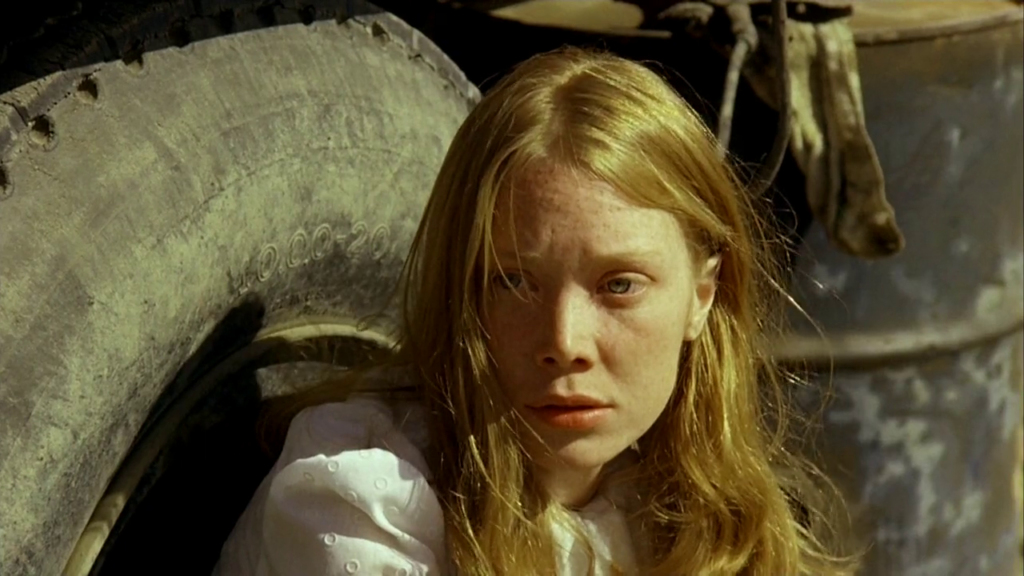
An unknown and untrained actress at the time, Sissy Spacek met 28-year-old Terrence Malick not long after she arrived in Los Angeles, and they immediately bonded over their mutual Southern roots: “He was an old soul, with an easy laugh and a gentle way about him. He spoke in a quiet drawl that I immediately recognized as coming from my corner of the world. We shared a love of the Southwest and small-town Texas. We’d both grown up there in the 1950s and were deeply connected to that time and place. From the moment we met, we felt like family. We knew the same things, and could communicate them without speaking. I was thankful that I’d ignored all those New York agents who told me to lose my accent and hide my Southern roots. Terry hired me for the film because of all those things. I hadn’t changed, I was still a small-town girl from Texas, that was what he wanted for the role of Holly Sargis, a naive, impressionable high school girl who falls for Kit Carruthers, a charming, sociopathic young garbage man who happens to shoot people.”
In one of his very rare interviews, for Sight & Sound in 1975, Terrence Malick described his female protagonist as “a typical Southern girl in her desire to help, to give hard fact, not to dwell upon herself, which to her would be unseemly, but always to keep in mind the needs of others. When they’re crossing the badlands, instead of telling us what’s going on between Kit and herself, she describes what they ate and what it tasted like, as though we might be planning a similar trip and appreciate her experience.”
Sissy was included in the film’s creative process from the very beginning. Terrence Malick even worked her twirling routine into the script after he found out she had been a majorette. Sissy was also included in the casting. “The moment Martin walked into the room, everything changed. The chemistry was immediate. Martin wore his hair slicked back and had a swagger like James Dean, and he looked plenty young. I had done that scene with dozens of actors – wonderful actors – but with Martin, it was completely different. He was Kit. And with him, I was Holly. Terry and I could hardly contain ourselves. After Martin left, we were like giddy school kids.”
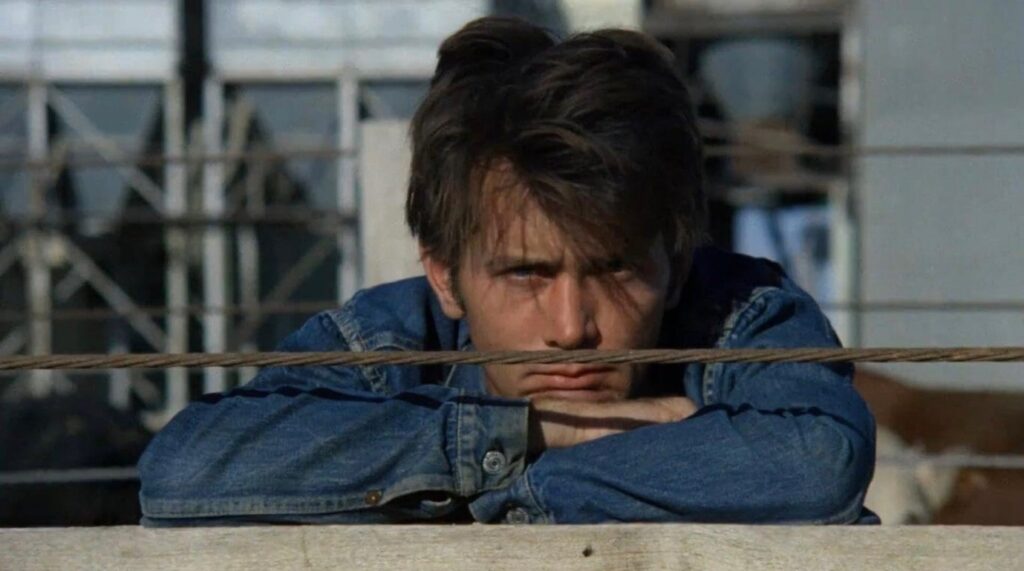
Initially deemed too old for the part, first by Terrence Malick (in the script, Kit was 19 years old) and then by himself when he read the script, Martin Sheen (31 at the time) eventually turned out to be perfect for the role as a 25-year-old misfit – Malick changed the character’s age to better serve the story and his actor. It’s incredibly moving how Martin Sheen recounts his casting in what he considered the role of his life: “Finally, someone had seen something in me that I knew was there but couldn’t get anyone else to see.” Malick gave both Martin Sheen and Sissy Spacek the freedom to inhabit their characters, coaxing the most nuanced performances from them. Just like Jack Fisk, Malick’s frequent art director and future husband of Sissy Spacek, who “would leave behind an abundance of riches, and a complete environment for us to work in.”
Kit is intriguing, projecting this mixed image of confidence, narcissism and indifference. A character who seems to appear from nowhere and which you don’t know what to do with, not unlike James Dean in the 1950s when the story of the rebel smoker in a red windbreaker became the story of an entire generation that grew up overnight. “Starkweather projected this very disarming image, everybody could relate to him,” Martin Sheen described his character in the documentary Making Badlands. “Murder spree aside, he was very, very interesting, and he gave us this insight glimpse into the very worst part of ourselves. His character, his image of himself, it made the country step back a little and say we’re more into image than reality. And this guy is a reflection of that.”
Reflecting on the character, Malick said in the Sight & Sound interview: “Kit [sees himself] as a subject of incredible interest to himself and to future generations. The movies have kept up a myth that suffering makes you deep. It’s not that way in real life, though, not always. Suffering can make you shallow and just the opposite of vulnerable, dense. It’s had this kind of effect on Kit.”
“So baby let’s sell your diamond ring.
Buy some boots and faded jeans and go away.
This coat and tie is choking me…”
-Waylon Jennings, Luckenbach, Texas
During the car chase, when the policemen are almost on top of him, Kit keeps checking his hair in the mirror. Kit fashions himself an outlaw eager for notoriety, an aimless garbage man who has the Dean look – “I guess I’ve always wanted to be a criminal, but just not this big a one,” he tells one of the policemen when asked why he did what he did. Immediately after, the policeman compares him to James Dean, and by the smile on Kit’s face that’s exactly what he had been after.
Kit wears his convictions, or lack thereof, on the outside. He is fit, wears a white T-shirt, blue jeans and a trucker denim jacket and smokes Lucky Strikes. He somehow knows that just by wearing that white t-shirt and blue jeans, he screams with defiance. He is also particularly fond of his two-toned cowboy boots with ornate leatherwork, which he wears all the time (whether deemed inappropriate by others or not), once again recalling James Dean, both on screen (Giant) and off (it was James Dean who made the cowboy boot the footwear of choice for the first rebel generation). Just like denims, the cowboy boot was secured in its place as a symbol of American history and individualism.
The 50s are kept to a bare minimum, which, reportedly, was Malick’s intention, and what better way to do that than using the look that had given the rebellious teenager without a cause an identity in the 1950s? Holly immediately associates Kit with James Dean in her voice-over narration. Kit draws a connection to James Dean throughout the entire film, from his clothes and the way he combs his hair, to the way he carries himself and the way he poses with a rifle slung over his shoulders, deliberately evoking Dean in Giant. Jeans even become symbolic of what is to come, when Holly sits on her porch, talking to Kit, him wearing his jeans and white tee… it’s that quiet moment before everything erupts, of waiting for someone, thinking of someone, becoming someone.
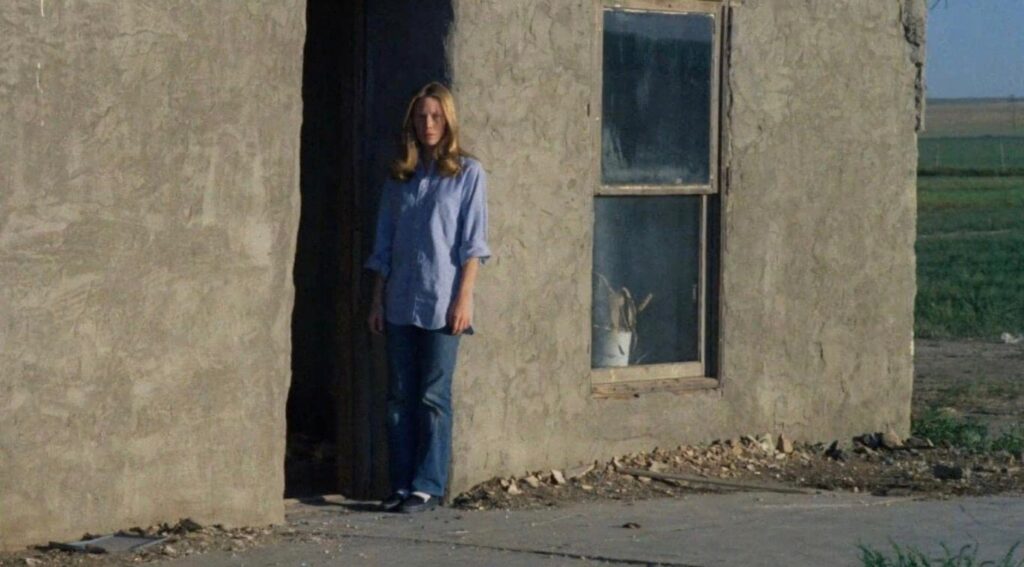
Terrence Malick didn’t want to make his film about the real story behind it. Neither did he seek to explain their crimes. Indifferent to the conventions of the American film industry, his story seems to exist outside conventions and outside time. “Terry always separated the reality and the brutality of the Starkweather incident from what we were doing,” Sissy Spacek recalled. “He never said this is that story, he didn’t want us to do research, he didn’t want me to look like Caril Ann, but I think that as a very young person, like the rest of the country, he was affected on a very deep level.” In the Sight & Sound interview, Terrence Malick named various other influences, such as the books The Hardy Boys, Swiss Family Robinson, Tom Sawyer, Huck Finn, “all involving an innocent in a drama over his or her head. I wanted the picture to be set up like a fairy tale, outside time, like Treasure Island.”
When Holly leaves with Kit, he makes her take her schoolbooks so that she doesn’t fall behind. But they soon get caught up in their own world, far from reality. They filmed on location in La Junta, Colorado. “Sometimes the sky seemed so blue and limitless that it had a weight of its own, pressing down on us and wiping out all memories of the other world beyond the one we inhabited at that very moment,” Sissy Spacek narrates in her book. “Out on the edge of nowhere, working with a virtuoso first-time director on a shoe-string budget and always perched on the edge of disaster, nothing else mattered, or even existed. It felt like we were the center of the universe.”
Sissy Spacek is totally believable as a 15-year-old (she was ten years older), and all the more unnerving as this blank, emotionally immature, compliant little girl. We meet her playing in the backyard, wearing white shorts and a navy t-shirt. She has a childlike inability to grasp the enormity of their actions, and everything that has to do with real life. Both Kit and Holly are incapable of reacting with any kind of emotion to the crimes, to death. In their relationship as well, although they are romantically involved, they seem to be like children role-playing.
For star-struck Holly, Kit could have come out right out of her film magazines. Kit and Holly know nothing about responsibility, like two aimless children on the road to nowhere. She compliantly follows Kit because she has a crush on him and because she doesn’t have any other ideas. This, unfortunately, is too much and too painfully a reflection of iGen, or the Internet Generation. Children who refuse to grow up, completely unprepared for maturity, ready to annihilate everyone who thinks differently because society is anyhow incapable of teaching them to think by themselves, so they remain passive and follow others, governed by the image culture, being perfectly okay with being told what to think. Luckily for Kit and Holly, their life remains a story, one of the greatest stories ever told, one in Terrence Malick’s unique style.
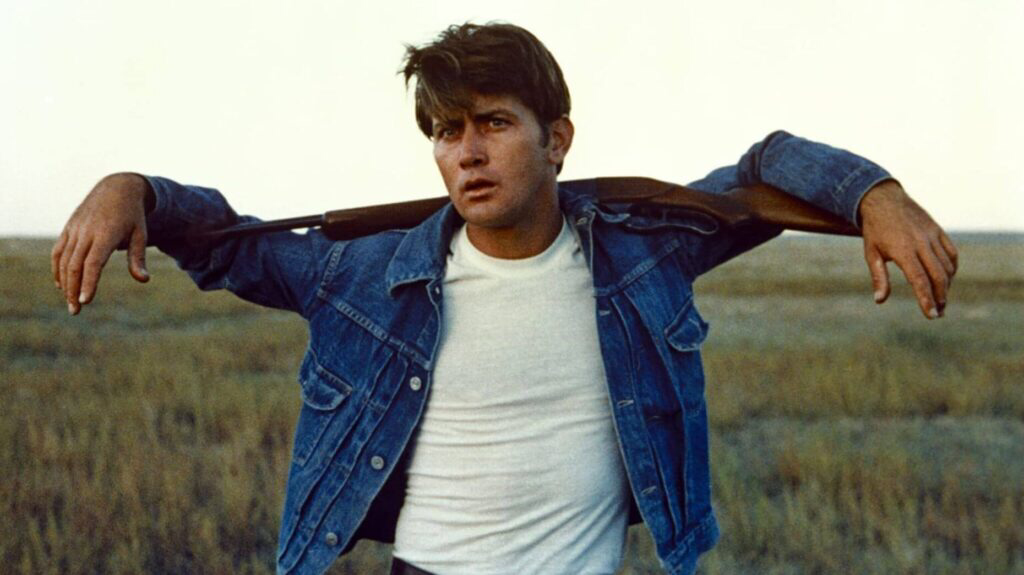
“I’d been a part of making a nearly perfect movie,” nostalgically concludes Sissy Spacek, “and if I never did another film again, it would be okay, because it was enough to have done Badlands. Terry Malick went on to direct a succession of brilliant, complex films, from Days of Heaven to The Tree of Life, always with Jack by his side as production designer. But nothing has ever really matched the magic of discovery we all felt that summer in the Colorado desert, when we learned how a film could be a living, breathing, collaborative work of art.”
